Performance Brakes Guide: Everything You Need To know. Why? Because there’s no such thing as brakes that are ‘too good’ is there? Here’s everything you need to know about braking and upgraded performance brakes. Better brakes make your car faster, it’s that simple. I mean, think about it, a braking system that’s more effective means you have to spend less time using it. Less time on the anchors essentially means more time on the throttle, and all that adds up to being real-world quicker through the twisty stuff. Of course, that’s not the only reason why a cheeky performance brakes upgrade is one of the most popular chassis mods out there. There’s also the real-world power tuning benefit. Most if the time it’s far more cost effective to upgrade your braking system than the relative amount of engine work needed for the same outcome on the road or track. What’s more, there’s nearly always room for improvement because standard braking systems are inevitably built to a budget. They’re also specifically designed to handle a little over the standard power and, depending on the car, in relatively normal driving conditions. Throw a spot of extra tuning into the mix, or any sort of fruity right foot action, and upgrading your brakes becomes pretty essential. Of course, better brakes are also safer, and you can’t really put a price on that, can you? So, here’s what you need to know…
The science
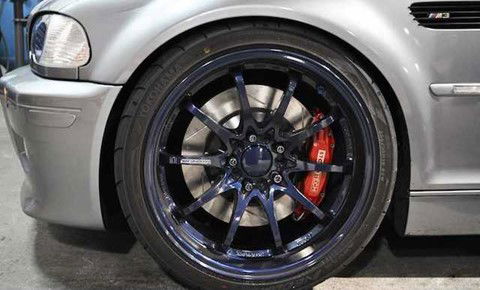
There’s two things we’re looking for in an effective Brake upgrade, the most obvious being improving vehicle stopping power by increasing the force that can be applied. The second, which is all too often overlooked, is simply increasing the amount of heat the system can safely dissipate. In other words, reducing the chance of the hardware overheating. Brake fade is the biggest problem when it comes to excess heat, but you still need some for brakes to work. It’s the friction caused by the pad rubbing on the disc (or the shoes the drum) that slows the car by converting the motion energy to heat energy. Obviously, the temperature is increased with how hard and how much the brakes are used, and it’s this which needs to be dissipated effectively. Upgrades are designed to do both.
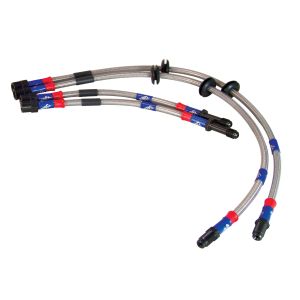
Your factory brake lines can rob your braking system of stopping power, especially when worn. The rubber hoses used from the factory in most vehicles can flex or bulge under load, particularly as they age. This means some of the force from you pushing your brake pedal is not transmitted to the brake callipers and pads. Replacing these rubber lines with Braided Steel Brake Hoses or Lines which do not flex means that when you push the brake pedal all the force is transmitted from your foot to the brake pads. This gives you more stopping power and more precise control over braking. Not only is no force lost, but the braided lines will have less slack in, so you will feel in more direct control over your car's braking. They also won’t expand with heat which comes into play when driving very hard on road, or on track. A PTFE inner and a sturdy braided stainless-steel outer are used. A plastic coating helps prevent dirt getting between the braided outer and the Teflon inner, prevent abrasion. The plastic coatings come in a variety of different colours. Hose fittings are available with a variety of different corrosion resistant coatings.
Drum brakes
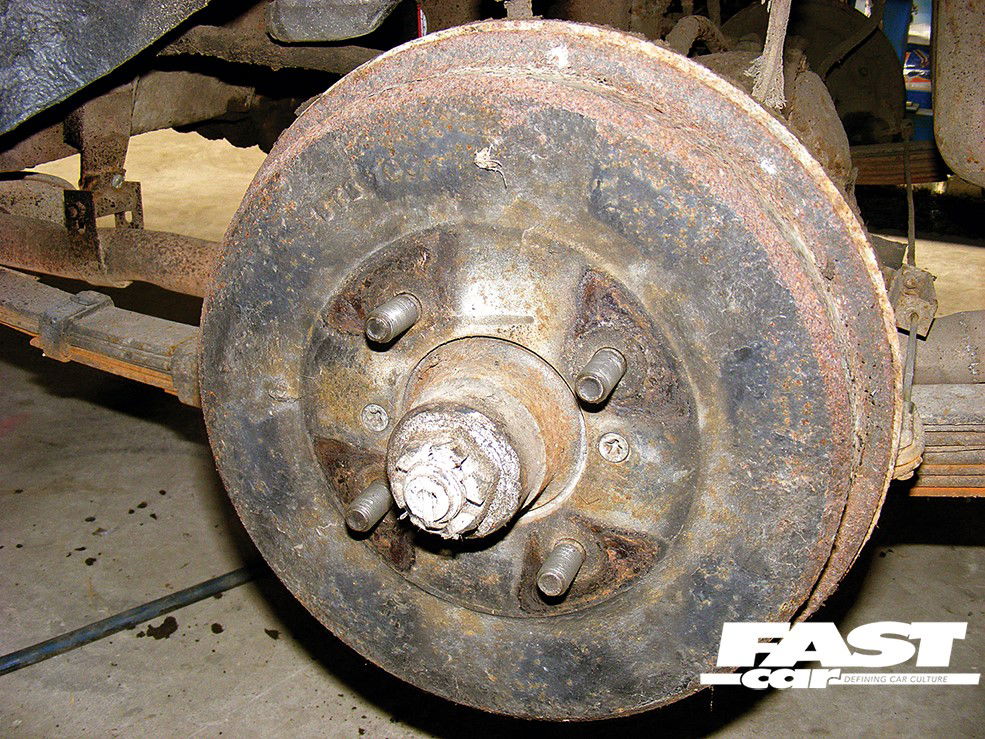
It’s true that you don’t find drums on many modern cars but, from a pure performance standpoint, drums are pretty effective up to point. The biggest problem they have is longevity because, under hard use, they generate and retain a huge amount of heat. This is why drums are notorious for being effective for a while then, rather suddenly, not being all that effective at all. Drums can be also grabby, going from nothing to total lockup in no time at all. In some cases, they can even stay locked on when you let off the pedal. There are some lightly uprated drum setups out there, the most common have grooves on the friction surface to help dissipate heat, or shoes with a softer performance compound. To be fair though, in the case of front brakes at least, you only find drums on the seriously old-school classics, and even then many simply choose to upgrade to discs.
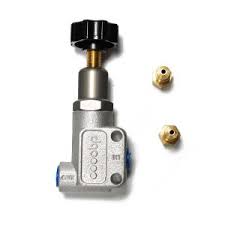
So, what about drums brakes on the rear? Well, some manufacturers still fit drums on the rear of lower-end cars because they just aren’t needed as much as the big powerful discs found on the front. Science tells us that, when you hit the anchors, the momentum of the vehicle will cause most of the weight to shift forwards. This is why the vast majority of cars have far larger brakes on the front than the rear. Of course, from a performance standpoint (and often when it comes to out-and-out looks) many choose to convert rear drums to discs, whether they’re needed or not. In that case, the key is always balance, with brakes on the rear that can overpower the front, you could be swapping ends in no time. Most of the time the rear brakes are responsible for under 30 percent of the stopping power and are used more for stability. In a disc setup, you’ll nearly always find the rear brakes use smaller callipers and smaller, thinner (often solid) discs. Front discs however will usually be far beefier and most often vented in the middle to help with dissipation.
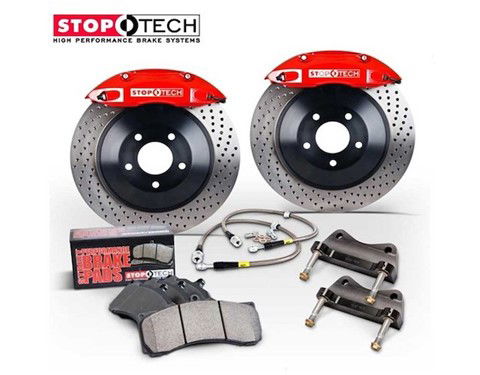
Unless you’re talking about cars of the retro variety, chances are you’ll find a set of discs under your front arches, luckily these have by far the widest range of upgrade options. With a disc brake system, there are 3 main parts to the hardware; the calliper assembly, the disc or rotor, and the pads. These all need to work in harmony to stop your car. The idea is actually pretty simple and revolves around hydraulic fluid being forced at high pressure into the calliper. Modern ‘power-assisted’ systems, use an in-line brake servo that amplifies the pressure you put on the master cylinder (via the pedal) using a vacuum created by the engine. Old school ‘non-servo’ systems rely more on pedal pressure and these are most commonly found on classic cars, although many race cars have the same simple setup, along with drivers sporting serious leg muscles! In both cases, when pressure is put on the middle pedal, the piston (or pistons) inside the caliper are then forced out against the pads which are, in turn, pushed against the disc to produce the friction that slows down and stops the car. Upgrading the system revolves around increasing the bite of the pads (through the choice of compound), the clamping force that can be applied by the callipers, the leverage on the disc, and the ability of the whole lot to effectively dissipate the heat produced.
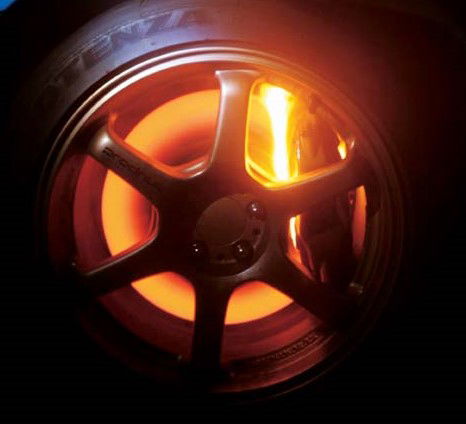
There are a number of reasons why you might want to fit Performance Brakes to your car. Here are a few of the most common:
- Improved stopping power: Performance brakes are designed to provide better stopping power than stock brakes. This is important for a number of reasons, including safety and performance.
- Reduced brake fade: Performance brakes are also designed to reduce brake fade. Brake fade is when the brakes start to lose their effectiveness after repeated use. This can be a problem if you are driving in a sporty or aggressive manner.
- Better heat management: Performance brakes are also designed to better manage heat. This is important for a number of reasons, including preventing brake fade and extending the lifespan of the brakes.
- Improved pedal feel: Performance brakes often have a better pedal feel than stock brakes. This can be a subjective matter, but many people find that performance brakes provide a more responsive and satisfying driving experience.
- Improved looks: Performance brakes can also improve the looks of your car. Many performance brake kits come with a variety of different colors and styles, so you can find a look that suits your taste.
Of course, there are also some drawbacks to fitting performance brakes to your car. One of the main drawbacks is that they can be expensive. Additionally, performance brakes can sometimes be noisy and can cause vibrations in the car. Overall, there are a number of reasons why you might want to fit performance brakes to your car. If you are looking for better stopping power, reduced brake fade, or improved pedal feel, then performance brakes may be a good option for you. However, it is important to weigh the pros and cons before making a decision.
Buy your brake kits @ DEMON TWEEKS PERFORMANCE
For Car Parts Try Euro Car Parts